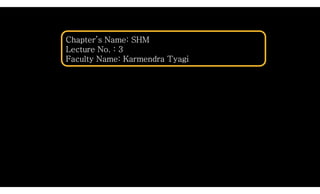crisitanosui apnikaksha.pdf
•
0 likes•2 views
shm and waves
Report
Share
Report
Share
Download to read offline

Recommended
Recommended
More Related Content
Similar to crisitanosui apnikaksha.pdf
Similar to crisitanosui apnikaksha.pdf (20)
7-asystem-of-practicles-and-rotational-motion (1).ppt

7-asystem-of-practicles-and-rotational-motion (1).ppt
CLASS XII - CHAPTER 5: OSCILLATION (PHYSICS - MAHARASHTRA STATE BOARD)

CLASS XII - CHAPTER 5: OSCILLATION (PHYSICS - MAHARASHTRA STATE BOARD)
Recently uploaded
ICT role in 21st century education
Role of ICT in education
Is importance to you knowing ICT role in 21st century education and it's challenges.pdf

ICT role in 21st century education and it's challenges.pdfIslamia university of Rahim Yar khan campus
in kuwait௹+918133066128....) @abortion pills for sale in Kuwait City Prixin kuwait௹+918133066128....) @abortion pills for sale in Kuwait City

in kuwait௹+918133066128....) @abortion pills for sale in Kuwait CityAbortion pills in Kuwait Cytotec pills in Kuwait
Recently uploaded (20)
Digital collaboration with Microsoft 365 as extension of Drupal

Digital collaboration with Microsoft 365 as extension of Drupal
Zone Chairperson Role and Responsibilities New updated.pptx

Zone Chairperson Role and Responsibilities New updated.pptx
Call Girls Near The Byke Suraj Plaza Mumbai »¡¡ 07506202331¡¡« R.K. Mumbai

Call Girls Near The Byke Suraj Plaza Mumbai »¡¡ 07506202331¡¡« R.K. Mumbai
ICT role in 21st century education and it's challenges.pdf

ICT role in 21st century education and it's challenges.pdf
Uncommon Grace The Autobiography of Isaac Folorunso

Uncommon Grace The Autobiography of Isaac Folorunso
Jual obat aborsi Jakarta 085657271886 Cytote pil telat bulan penggugur kandun...

Jual obat aborsi Jakarta 085657271886 Cytote pil telat bulan penggugur kandun...
Lions New Portal from Narsimha Raju Dichpally 320D.pptx

Lions New Portal from Narsimha Raju Dichpally 320D.pptx
in kuwait௹+918133066128....) @abortion pills for sale in Kuwait City

in kuwait௹+918133066128....) @abortion pills for sale in Kuwait City
Unlocking Exploration: Self-Motivated Agents Thrive on Memory-Driven Curiosity

Unlocking Exploration: Self-Motivated Agents Thrive on Memory-Driven Curiosity
AWS Data Engineer Associate (DEA-C01) Exam Dumps 2024.pdf

AWS Data Engineer Associate (DEA-C01) Exam Dumps 2024.pdf
SOLID WASTE MANAGEMENT SYSTEM OF FENI PAURASHAVA, BANGLADESH.pdf

SOLID WASTE MANAGEMENT SYSTEM OF FENI PAURASHAVA, BANGLADESH.pdf
LITTLE ABOUT LESOTHO FROM THE TIME MOSHOESHOE THE FIRST WAS BORN

LITTLE ABOUT LESOTHO FROM THE TIME MOSHOESHOE THE FIRST WAS BORN
crisitanosui apnikaksha.pdf
- 1. Chapter’s Name: SHM Lecture No. : 3 Faculty Name: Karmendra Tyagi
- 2. A particle of mass 2 kg is moving on a straight line under the action force F = (8 - 2x) N. It is released at rest from x = 6m. (A) Is the particle moving simple harmonically? (B)Find the equilibrium position of the particle. (C) Write the equation of motion of the particle. (D) Find the time period of SHM.
- 3. SHM AS A PROJECTION OF UNIFORM CIRCULAR MOTION.
- 4. SHM AS A PROJECTION OF UNIFORM CIRCULAR MOTION.
- 5. SHM AS A PROJECTION OF UNIFORM CIRCULAR MOTION. -A +A +A -A
- 6. SHM AS A PROJECTION OF UNIFORM CIRCULAR MOTION. If the particles cross each other , they are equal phase away from x axis. If the particles are at maximum separation from each other , they are equal phase away from y axis.
- 7. Two particles undergo SHM along parallel lines with the same time period (T) and equal amplitudes. At a particular instant, one particle is at its extreme position while the other is at its mean position. They move in the same direction. Find the time when they cross each other.
- 8. Two particles execute SHM of same amplitude of 20 cm with same period along the same line about the same equilibrium position. If phase difference is /3 then find out the maximum distance between these two.
- 9. Two particles execute SHM of same time period but different amplitudes along the same line. One starts from mean position having amplitude A and other starts from extreme position having amplitude 2A. Find out the time when they both will meet?
- 12. Potential Energy (U) of a body of unit mass moving in a one-dimension conservative force field is given by, U = (x2 – 4x + 3). All units are in S.I. (i) Find the equilibrium position of the body. (ii) Show that oscillations of the body about this equilibrium position is simple harmonic motion & find its time period. (iii) Find the amplitude of oscillations if speed of the body at equilibrium position is 2 6 m/s.
- 14. ENERGY OF SHM
- 15. • A particle performing pure SHM does not dissipate energy and continues to perform similar motion periodically • Only conservative forces do work during SHM • Total energy of a particle performing SHM (mechanical energy) remains constant ENERGY OF A PARTICLE PERFORMING SHM
- 16. KINETIC ENERGY • Max K.E at mean position • Min K.E at extreme (zero) • Decreases as we go away from mean position
- 17. POTENTIAL ENERGY Let minimum potential energy be Um (at mean position)-
- 18. THE GRAPHS OF ENERGIES/POSITION For mean position at origin and minimum potential energy to be zero- m=0 x E x=+A x=-A K.E P.E T.E t
- 19. Potential Energy (U) of a body of mass 2 kg moving in a one- dimension conservative force field is given by, U = (x2 – 4x + 3). If total energy of the particle is 8 J determine- (i) Maximum speed of the particle (ii) Amplitude of the oscillation (All units are in S.I.)
- 20. Ans-d
- 21. ENERGY/TIME GRAPH- K.E t Kinetic/Potential energy perform SHM of double frequency/ half time period P.E t
- 22. The average kinetic energy in one-time period in simple harmonic motion is- (Assume minimum potential energy to be zero) (D) Zero
- 23. A body is executing simple harmonic motion. At a displacement x from mean, its potential energy is E1 and at a displacement y from mean, its potential energy is E2. The potential energy E at a displacement (x + y) is- (Given minimum potential energy is zero) (A) E1 + E2 (B) (C) E1 + E2 + (D)